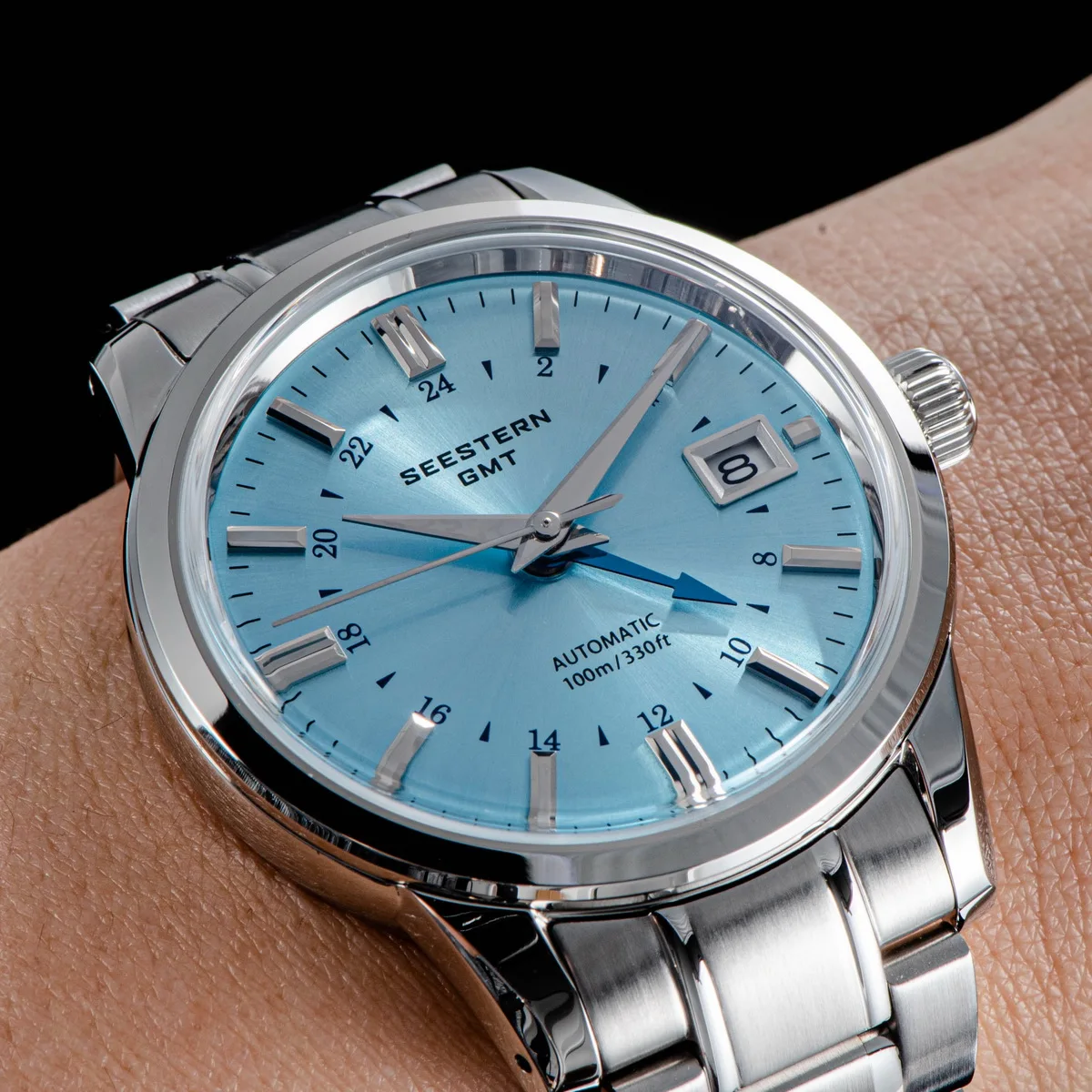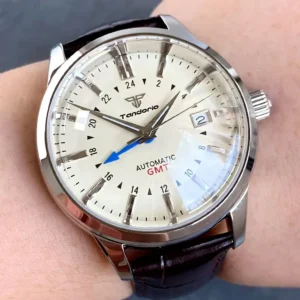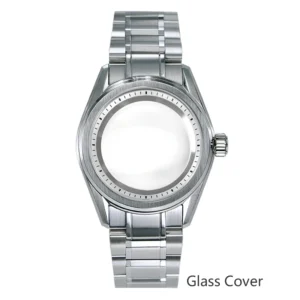Understanding GMT Watches and Dive Watches: Core Components and Definitions
When exploring the world of premium timepieces, few combinations offer as much practical versatility as GMT dive watches. But before diving into this specialized category, it’s essential to understand what makes both GMT watches and dive watches distinct on their own.
A GMT watch features a specialized complication that allows you to track multiple time zones simultaneously. The key component is an additional 24-hour hand that makes one complete rotation per day (rather than the usual 12 hours). This hand points to a 24-hour scale, typically found on the bezel or dial, enabling you to read a second time zone at a glance.
The history of GMT watches traces back to the golden age of commercial aviation. As intercontinental flights became commonplace, pilots needed a reliable way to track both their origin time zone and Greenwich Mean Time (GMT) – the global time standard from which all other time zones are calculated. What began as a specialized tool for aviation professionals eventually evolved into an essential accessory for international travelers of all types.
On the other side of the horological spectrum, dive watches were created with an entirely different purpose: to serve as reliable timing instruments underwater. Understanding GMT on dive watches requires recognizing that these timepieces must meet specific technical requirements to ensure functionality and safety in challenging aquatic environments.
True dive watches must offer:
– Water resistance of at least 100 meters, though professional models typically provide 200-300 meters or more
– A unidirectional rotating bezel to track elapsed time (which only turns counterclockwise as a safety feature)
– Exceptional luminosity for underwater visibility
– Robust case construction that can withstand pressure changes
– High legibility under various lighting conditions
Many professional dive watches conform to the ISO 6425 international standard, which establishes rigorous criteria for water resistance, durability, anti-magnetism, and functional reliability. These stringent requirements ensure that automatic dive watches perform reliably when lives may depend on accurate timekeeping.
Understanding these foundations is crucial before exploring how manufacturers have ingeniously combined these seemingly disparate functions into single, versatile timepieces that serve both travelers and underwater enthusiasts alike.
The Strategic Combination: Why GMT Functions Enhance Dive Watches
At first glance, combining GMT functionality with a dive watch might seem counterintuitive. After all, one function serves travelers crossing time zones, while the other serves those descending beneath the waves. However, this combination makes perfect sense when considering the evolving needs of modern adventurers and professionals.
The primary appeal of GMT dive watches lies in their versatility. Rather than carrying multiple specialized watches, users gain a single timepiece that transitions seamlessly between various environments and activities. This combination appeals particularly to:
- Professional divers who travel internationally for work
- Marine biologists conducting research across different regions
- Underwater photographers on global assignments
- Recreational divers planning dive trips abroad
- Business travelers who enjoy diving during leisure time
- Watch enthusiasts who appreciate technical complexity
The advantages of GMT function in divers extend beyond mere convenience. For professional dive teams operating across time zones, the ability to coordinate activities with support crews or research teams back home becomes invaluable. The GMT function allows for instant time calculations without removing diving equipment or waiting until after a dive.
These watches exemplify what enthusiasts call “go anywhere, do anything” (GADA) timepieces – versatile tools that perform admirably across various environments and situations. As our lives become increasingly mobile and multi-faceted, the demand for such versatility has grown substantially.
This combination also reflects a broader trend toward multi-functional tool watches that serve practical purposes while making strong aesthetic statements. The distinct visual elements of GMT vs dive watches – the additional colored hand, the 24-hour scale, and the robust dive-ready construction – create unique design opportunities that many manufacturers have embraced with creative flair.
Understanding this strategic combination provides context for the technical challenges manufacturers face when merging these functions and helps explain why these specialized timepieces often command premium pricing in the watch market.
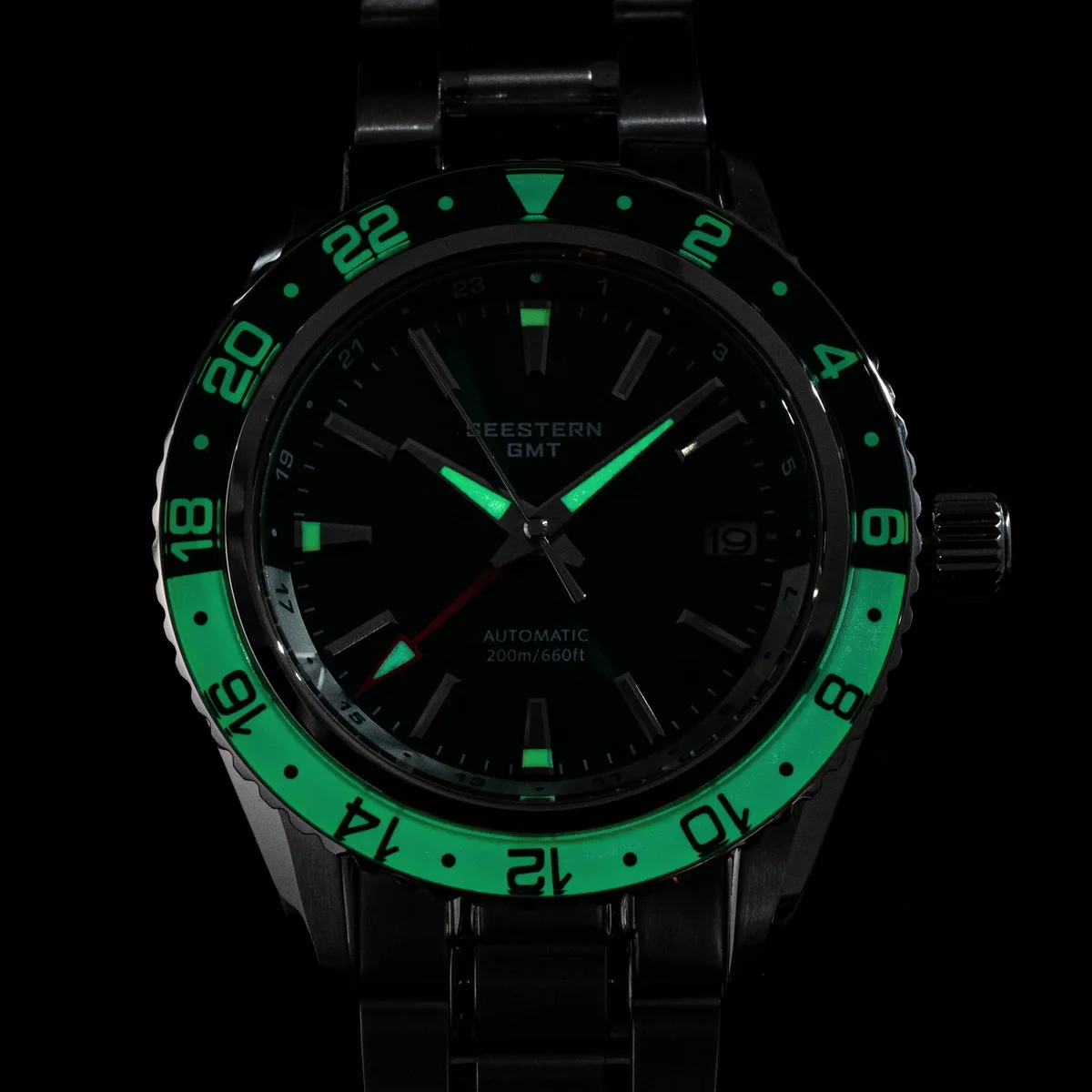
GMT Mechanisms Explained: How They Function in Dive Watches
To truly appreciate GMT dive watches, it’s essential to understand the mechanical ingenuity that powers their multi-timezone functionality. The key component in any GMT watch is the additional 24-hour hand, which completes one full rotation every 24 hours – half the speed of the standard hour hand.
This dedicated GMT hand works in conjunction with a 24-hour scale to display a second time zone clearly. What makes this system particularly valuable is its ability to distinguish between AM and PM hours in the second time zone, eliminating the confusion that can occur with standard 12-hour displays.
When it comes to understanding GMT complications in dive watches, it’s important to recognize that not all GMT mechanisms are created equal. The watch industry generally recognizes two distinct types:
True GMT (Traveler/Flyer GMT)
– The local hour hand can be independently adjusted forward or backward in one-hour increments
– The GMT hand remains fixed to home time when adjusting local time
– Ideal for frequent travelers who change time zones regularly
– Setting procedure:
1. Pull the crown to first position to adjust the local hour hand in one-hour jumps
2. The date will change when the hour hand passes midnight
3. The GMT hand maintains home time reference
Caller GMT (Office GMT)
– The GMT hand can be independently adjusted in one-hour increments
– The main hour and minute hands remain fixed to local time
– Better suited for those who regularly communicate with people in different time zones
– Setting procedure:
1. Pull the crown to first position to adjust the GMT hand in one-hour increments
2. Local time remains unchanged during adjustment
Reading the second time zone requires a simple process: the GMT hand points to the corresponding hour on the 24-hour scale. If using a GMT bezel, you can rotate it to track a third time zone, further enhancing the watch’s functionality.
These GMT automatic watches contain movements significantly more complex than standard three-hand automatics. The additional components required to enable independent hand adjustment and proper synchronization with the date mechanism demand precision engineering and careful assembly.
For dive watch manufacturers, incorporating GMT functionality requires solving several technical challenges. The movement must remain robust enough to withstand the pressure and environmental stresses of diving while accommodating the additional GMT mechanism. This balancing act between complexity and reliability explains why GMT dive watches often represent the more sophisticated offerings in a brand’s lineup.
Bezel Integration: The Technical Challenge of Combining Dive and GMT Functions
One of the most significant design challenges in creating effective GMT dive watches lies in bezel integration. Dive watches and GMT watches traditionally use their bezels for different, sometimes contradictory purposes.
A traditional dive watch bezel serves as a crucial safety feature. Its unidirectional rotation (counterclockwise only) ensures that any accidental bumps can only result in an overestimation of elapsed dive time – a much safer error than underestimation. This bezel typically features minute markings for tracking dive time, with prominent numerals at 15, 30, and 45 minutes.
Conversely, a GMT bezel serves an entirely different function: displaying a 24-hour scale to work with the GMT hand. These bezels are typically bidirectional for easier adjustment and feature hour markings rather than minute markings. They often employ contrasting colors (commonly blue/red or black/blue) to visually distinguish day hours from night hours.
Decoding dive watch GMT functionality reveals three primary approaches manufacturers use to reconcile these competing requirements:
1. Unidirectional Dive Bezel with Internal GMT Scale
– Preserves the safety-critical unidirectional dive bezel externally
– Incorporates a 24-hour scale on an internal rotating flange or fixed rehaut
– Maintains dive timing functionality while adding GMT capability
– Sometimes uses a secondary crown to adjust the internal GMT scale
2. Bidirectional GMT Bezel with Dive Timing Markings
– Prioritizes GMT functionality with a bidirectional 24-hour bezel
– Incorporates minute markings alongside hour numerals for basic dive timing
– Sacrifices the safety feature of unidirectional rotation
– Better suited for recreational diving or as primarily travel watches with secondary dive capabilities
3. Hybrid Solutions with Innovative Mechanisms
– Dual bezel systems with both functions separated
– Specialized locking mechanisms that can switch between unidirectional and bidirectional rotation
– Interchangeable bezel inserts for different activities
– Additional digital displays complementing analog functions
Each approach represents different priorities in the GMT dive watches category. The design challenge extends beyond mere functionality – manufacturers must also ensure legibility, ease of operation (especially with gloves), and aesthetic coherence. The bezel must remain grippable, clearly marked, and aligned precisely with the dial indicators.
The most successful executions maintain the distinctive visual identity of both watch types while ensuring neither function compromises the other. This delicate balance of technical requirements, safety considerations, and design aesthetics exemplifies the sophisticated engineering behind premium GMT dive watches.
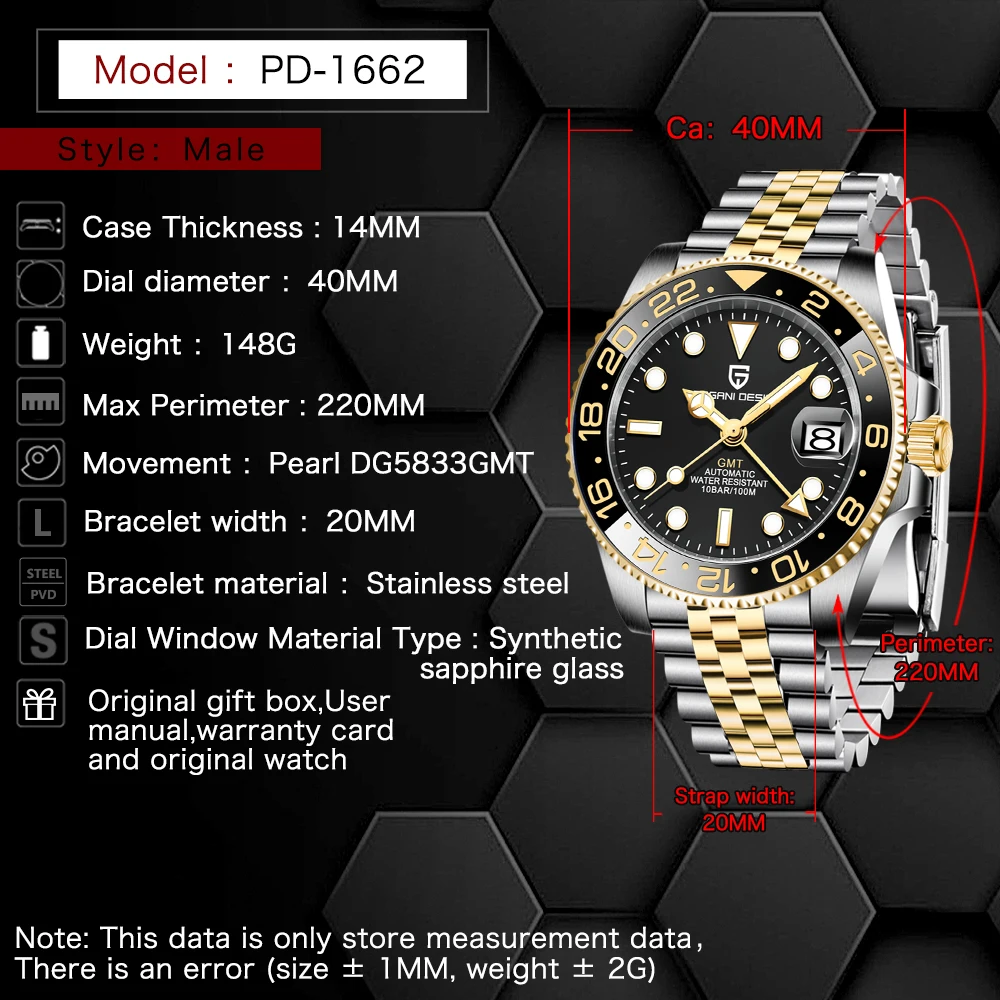
Practical Applications: Real-World Benefits of GMT Dive Watches
The unique combination of features in GMT dive watches creates specific advantages in several real-world scenarios. Understanding these practical applications helps clarify why many enthusiasts and professionals value these specialized timepieces.
International Travel to Dive Destinations
For recreational divers who travel globally to experience different underwater environments, GMT dive watches offer unmatched convenience:
– Track local dive site time while maintaining awareness of home time for communications
– Easily coordinate with dive shops operating on local schedules
– Schedule dive activities while maintaining awareness of family/work time zones
– Eliminate the confusion of calculating time differences during travel fatigue
As one frequent traveler explained in a watch forum, “When I’m in Bali calculating nitrogen off-gassing times between dives, the last thing I want to worry about is whether I’m calling home at 3 AM by mistake.”
Professional Marine Applications
For those working in marine-related fields, GMT dive watch use cases extend to numerous professional scenarios:
– Marine biologists coordinating research activities across international teams
– Underwater photographers tracking client deadlines across time zones
– Commercial divers synchronizing operations with surface teams in different regions
– Dive instructors managing certification courses with international headquarters
The combination proves particularly valuable when operations span multiple countries or coordinate with vessels traversing time zones. The ability to track both local operating time and reference time without electronic devices (which may fail in marine environments) provides crucial redundancy.
Business Travel with Recreational Diving
Many professionals who enjoy diving during business trips find particular value in GMT dive watches:
– Transition seamlessly from business meetings to recreational dives
– Maintain awareness of office hours while enjoying underwater activities
– Single timepiece suitable for both professional and leisure environments
– Reduced need to travel with multiple watches for different activities
These versatile timepieces complement the lifestyle of the modern professional who values both career and adventure. Professional-spec dive watches with GMT functionality offer the robustness needed for underwater use while providing the sophisticated appearance appropriate for business settings.
Beyond pure functionality, GMT dive watches hold particular appeal for watch enthusiasts who appreciate technical complexity and versatility. The combination represents a pinnacle of tool watch design – functional, purpose-built instruments that serve multiple practical needs while showcasing mechanical ingenuity.
Limitations and Considerations: What to Be Aware Of
While GMT dive watches offer impressive versatility, potential buyers should understand several important limitations and considerations before making a purchase decision.
Dial Complexity and Legibility Concerns
The addition of GMT functionality inevitably increases dial complexity:
– Extra hand and scale can create visual clutter
– Smaller text or markers may be harder to read underwater
– Color coding for GMT functions may compromise dive watch legibility standards
– Luminosity may be distributed across more elements, reducing effectiveness
For serious divers, this increased complexity could potentially impact quick time readings in critical situations. The best designs mitigate these issues through careful dial layout and distinct hand shapes, but the tradeoff between functionality and legibility remains an important consideration.
Cost Implications
The GMT complication adds significant cost to dive watches for several reasons:
– More complex movements with additional components
– Higher manufacturing precision requirements
– More sophisticated testing procedures
– Increased design and engineering investment
Consumers should expect a price premium compared to standard dive watches with similar build quality. This premium reflects both the increased manufacturing costs and the added utility of the GMT function.
Functional Compromises
When comparing GMT vs dive watch functionality, certain compromises become apparent:
– Some GMT dive watches feature bidirectional bezels that lack the safety feature of traditional dive bezels
– Bezel markings may prioritize one function over another, reducing usability for secondary functions
– The complexity of setting procedures may increase risk of error
– Water resistance ratings may sometimes be lower than dedicated dive watches
These compromises don’t necessarily make GMT dive watches unsuitable for either purpose, but users should understand these design tradeoffs when evaluating options for their specific needs.
Maintenance Considerations
The increased complexity of GMT mechanisms demands additional maintenance awareness:
– More components create more potential failure points
– Service intervals may need to be more strictly observed
– Finding qualified technicians for repairs may be more challenging
– Setting procedures require greater care to ensure proper synchronization
For those using the watch in demanding environments, these maintenance considerations should factor into the ownership decision, particularly for mechanical rather than quartz models.
Understanding these limitations helps set realistic expectations for GMT dive watches. Despite these considerations, many users find the versatility and convenience outweigh these potential drawbacks, especially when the watch is chosen with specific use cases in mind.
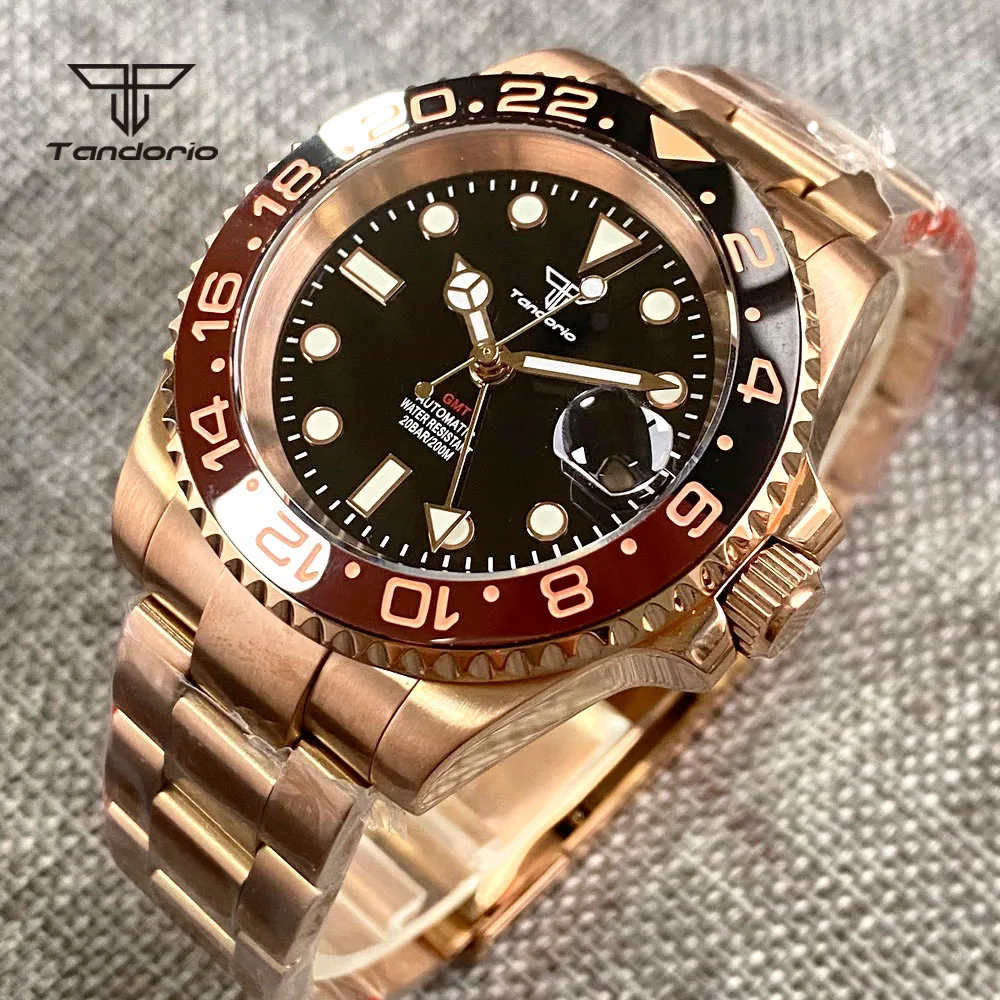
Buyer’s Guide: Essential Features to Look For in GMT Dive Watches
Selecting the right GMT dive watch requires careful consideration of several key features that balance both dive functionality and GMT capability. This guide helps you identify the most important elements to evaluate during your selection process.
Dive Watch Credentials
Water resistance should remain a top priority for any dive watch, regardless of additional complications:
– 200m water resistance is the practical minimum for actual diving
– 300m or greater provides a comfortable safety margin for recreational diving
– Look for screw-down crowns and case backs that enhance water resistance
– Helium escape valves may be valuable for professional saturation divers
Bezel functionality directly impacts diving safety:
– Unidirectional rotation prevents accidental increases in perceived dive time
– Adequate grip allows operation with gloves or wet hands
– Clear minute markings facilitate precise dive timing
– Solid click mechanism prevents accidental movement
Luminosity remains essential for underwater visibility:
– Super-LumiNova or similar photoluminescent material on hands and markers
– Distinct luminous colors to differentiate hour, minute, and GMT hands
– Luminous pip at zero/60 position on the bezel
– Extended luminosity duration for longer dives
GMT Implementation Quality
The movement type significantly impacts functionality and user experience:
– True GMT (Traveller) movements offer easier adjustment for frequent travelers
– Caller GMT movements may suffice for those primarily tracking a single additional time zone
– Evaluate the smoothness of adjustment mechanisms
– Consider power reserve duration for mechanical options
The GMT dive watch layouts should be evaluated for clarity and usability:
– Contrasting colors for the GMT hand improves readability
– Clear 24-hour scale markings prevent misreading
– Day/night indication through color coding aids quick reference
– Position of the 24-hour scale (bezel vs. chapter ring) affects ease of use
Build Quality and Materials
Material selection directly impacts both durability and comfort:
– Stainless steel offers excellent durability and corrosion resistance
– Titanium provides lighter weight and hypoallergenic properties
– Ceramic bezel inserts resist scratching and fading
– Sapphire crystal offers superior scratch resistance
Bracelet or strap options should complement the intended use:
– Metal bracelets with diver’s extensions accommodate wetsuit compression
– Rubber straps provide comfort and durability in saltwater
– Quick-change systems allow versatility between environments
– Secure clasp mechanisms prevent accidental opening
Brand Reputation and Reliability
When investing in a complex timepiece like a GMT dive watch, brand reputation provides important assurance:
– History of producing reliable dive instruments
– Quality control standards and testing procedures
– Service network availability and parts supply
– Warranty coverage specific to water resistance claims
By methodically evaluating these features, you can identify a mastering multi-timezone GMT functions watch that genuinely meets your specific needs rather than simply responding to marketing claims or aesthetics alone.
Notable GMT Dive Watch Market Segments and Models
The market for GMT dive watches spans several price segments, each offering distinct approaches to combining these functionalities. Understanding these segments helps identify options that match both budget and requirements.
Luxury Segment
Luxury GMT dive watches represent the pinnacle of this category, featuring:
– In-house manufactured movements with True GMT functionality
– Exceptional finishing on all components
– Innovative technical solutions to the GMT-dive integration challenge
– Premium materials like 904L steel, grade 5 titanium, and ceramic
– Heritage of diving instrument development
These premium timepieces often feature unique technical approaches such as concentric bezels, advanced locking crown systems, and proprietary movement innovations that enhance both GMT and diving functionality. The value proposition centers on engineering excellence, brand heritage, and exceptional craftsmanship that ensures decades of reliable service.
Mid-Range Segment
The mid-range segment offers compelling value through:
– High-quality third-party movements modified for GMT functionality
– Excellent build quality with careful attention to dial legibility
– Smart compromises that preserve essential functionality
– Diverse aesthetic approaches from vintage-inspired to contemporary
– Strong performance-to-price ratio
Watches in this category frequently balance the pure tool watch ethic with design flourishes that enhance visual appeal. Many feature Caller GMT functionality rather than True GMT, but compensate with excellent execution of dive watch essentials like water resistance, luminosity, and bezel action. These represent the sweet spot for many enthusiasts who want both functions without luxury pricing.
Accessible/Entry-Level Segment
More affordable GMT dive watches have democratized this formerly exclusive category through:
– Reliable quartz movements that reduce complexity and cost
– Focused functionality that prioritizes essential features
– Creative use of materials to control costs while maintaining durability
– Simplified design approaches that maintain legibility
– Accessibility for newcomers to the watch hobby
While these watches may lack the refinement or technical sophistication of higher-priced options, many deliver genuinely useful functionality for recreational divers who travel. They typically feature Caller GMT mechanisms and may make modest compromises on water resistance (200m vs. 300m+) or materials (mineral vs. sapphire crystals).
Across all segments, buyers can find diverse approaches to the GMT-dive integration, from models that prioritize dive functionality with secondary GMT features to those that emphasize travel functionality while maintaining adequate dive capabilities. The titanium automatic watches category has seen particular innovation, with lightweight yet durable options ideal for travel and diving.
Classic Automatic Dress Watches, GMT Automatic Watches, GMT Pilot Watches
Price range: $1,240.86 through $1,463.33 Select options This product has multiple variants. The options may be chosen on the product pageAutomatic Chronograph Watches, Classic Style Dive Watches
$3,053.06 Select options This product has multiple variants. The options may be chosen on the product pageBronze Automatic Watches, Military Inspired Automatic Watches, Professional Spec Dive Watches
Price range: $1,442.21 through $1,442.82 Select options This product has multiple variants. The options may be chosen on the product pageProfessional Spec Dive Watches, Titanium Automatic Watches
$574.74 Select options This product has multiple variants. The options may be chosen on the product pageClassic Automatic Dress Watches, GMT Automatic Watches, GMT Dive Watches
Price range: $468.93 through $552.94 Select options This product has multiple variants. The options may be chosen on the product pageGMT Automatic Watches, Unique Automatic Watches
$420.10 Select options This product has multiple variants. The options may be chosen on the product page
Current Innovations: How Manufacturers are Evolving GMT Dive Watches
The GMT dive watch category continues to evolve through technical innovation and creative design approaches. These developments enhance functionality while addressing some of the traditional limitations of these multi-purpose timepieces.
Movement innovation represents perhaps the most significant area of advancement. Manufacturers have developed increasingly sophisticated calibers that offer:
– Extended power reserves of 70+ hours, ideal for weekend transitions between activities
– Quickset GMT hands that simplify adjustments during travel
– Improved accuracy specifications under varying conditions
– More efficient winding systems requiring less wrist motion
Material science has similarly transformed the landscape of can you use GMT watch diving possibilities through:
– Advanced ceramic composites for bezels that resist scratching and fading even in marine environments
– Gradient-colored sapphire crystals that enhance GMT scale legibility
– Innovative luminous compounds that maintain brightness longer underwater
– Anti-magnetic alloys that protect movement accuracy near electronic equipment
Display innovations have addressed the perennial challenge of balancing complexity with legibility:
– Multi-layer dials that separate dive and GMT information for easier reading
– Color-contrast optimization based on underwater visibility research
– Increased hand differentiation through distinct profiles and finishes
– Optimized date displays that remain legible without compromising the dial layout
The market has also witnessed significant contributions from independent watchmakers and microbrands, who have introduced fresh perspectives on GMT dive watch design. These smaller companies often take creative risks that larger manufacturers avoid, resulting in novel approaches to bezel design, dial layout, and functionality integration.
Consumer preferences have shifted toward versatile tool watches that can transition between environments, driving increased development in this category. As remote work becomes more common and travel resumes, watches that elegantly combine multiple functions have gained popularity among enthusiasts and casual wearers alike.
Sharp Aspect has noted this trend toward sophisticated multi-function timepieces, recognizing that today’s watch buyers increasingly seek versatility alongside traditional quality markers like movement performance and build quality. The most successful recent releases in this category reflect thoughtful integration rather than simply adding complications to existing designs.
Is a GMT Dive Watch Right for You? Matching Features to Your Needs
Determining whether a GMT dive watch suits your lifestyle requires honest assessment of your actual needs and preferences. Consider these key questions to guide your decision:
How do you plan to use the watch?
If you frequently travel internationally and engage in water activities, a GMT dive watch offers genuine practical benefits. The combination eliminates the need to switch watches between business meetings and recreational dives, or to reset your watch when communicating with people back home.
However, if you rarely cross time zones or participate in serious diving, you might be better served by a specialized watch that excels at a single function rather than compromising for versatility.
What type of diving do you do?
For recreational divers who stay within no-decompression limits and dive with computers, a GMT dive watch serves well as a reliable backup timing device with added travel functionality.
Professional divers or those engaging in technical diving might prioritize dedicated dive instruments with maximum legibility and specialized features over the added complexity of GMT functionality.
Do you value versatility in your accessories?
Many watch enthusiasts appreciate the “one watch solution” that GMT dive watches represent. If you prefer minimalist travel or dislike changing watches for different activities, this combination offers significant convenience.
Conversely, collectors who enjoy owning specialized tools for different purposes might prefer dedicated dive watches and separate GMT or travel watches, each optimized for its primary function.
What’s your tolerance for complexity?
GMT dive watches inherently involve more complex operation than standard watches. Setting multiple time zones, understanding AM/PM differentiation in the 24-hour format, and maintaining proper synchronization requires more attention to detail.
If you prefer straightforward operation with minimal adjustments, a simpler timepiece might better suit your preferences.
Those fascinated by the history of dive watch engineering often appreciate the technical achievement that GMT dive watches represent, finding satisfaction in mastering their more complex functionality.
The Aesthetic Dimension
Beyond pure functionality, consider whether the distinctive aesthetic of GMT dive watches appeals to you. The additional hand, the typically colorful GMT scales, and the robust proportions create a distinctive look that many find appealing independently of practical concerns.
Your answers to these questions will help determine whether the investment in a GMT dive watch makes sense for your specific circumstances and preferences.
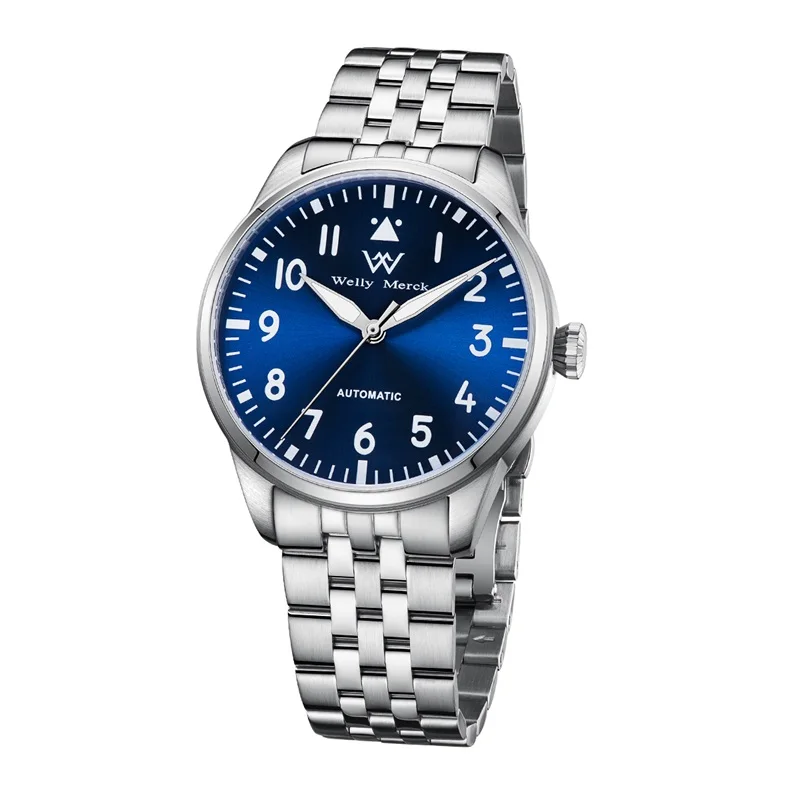
The Enduring Appeal of GMT Dive Watches: Form Meets Function
GMT dive watches continue to captivate watch enthusiasts and practical users alike because they exemplify the perfect marriage of form and function. These timepieces transform what could be a contradictory combination into a harmonious whole that’s greater than the sum of its parts.
The enduring appeal lies in their versatility – the ability to transition seamlessly between environments and functions without compromise. From boardroom to beach, from airport to underwater adventure, these watches maintain their functionality and style, eliminating the need for multiple specialized timepieces.
The technical sophistication of GMT dive watches also tells a compelling story of horological innovation. The engineering challenges of integrating these distinct functions have pushed watchmakers to develop creative solutions that advance the craft as a whole. Each watch represents countless hours of design refinement, technical problem-solving, and precision manufacturing.
For the modern adventurer, these watches serve as reliable companions across various environments and situations. They symbolize readiness for whatever might come next – whether that’s an unexpected business trip, a spontaneous diving opportunity, or simply the need to coordinate across global time zones.
What began as a seemingly paradoxical combination has evolved into one of the most practical and respected watch categories available today. The GMT dive watch stands as testament to how traditional watchmaking continues to evolve and adapt to our changing world while maintaining the core principles of reliability, functionality, and craftsmanship.
In a digital age where specialized devices proliferate, there remains something profoundly satisfying about a mechanical instrument that elegantly combines multiple functions through ingenious design rather than electronic shortcuts. This blend of traditional craftsmanship with practical versatility ensures that GMT dive watches will remain relevant and desirable for generations to come.

